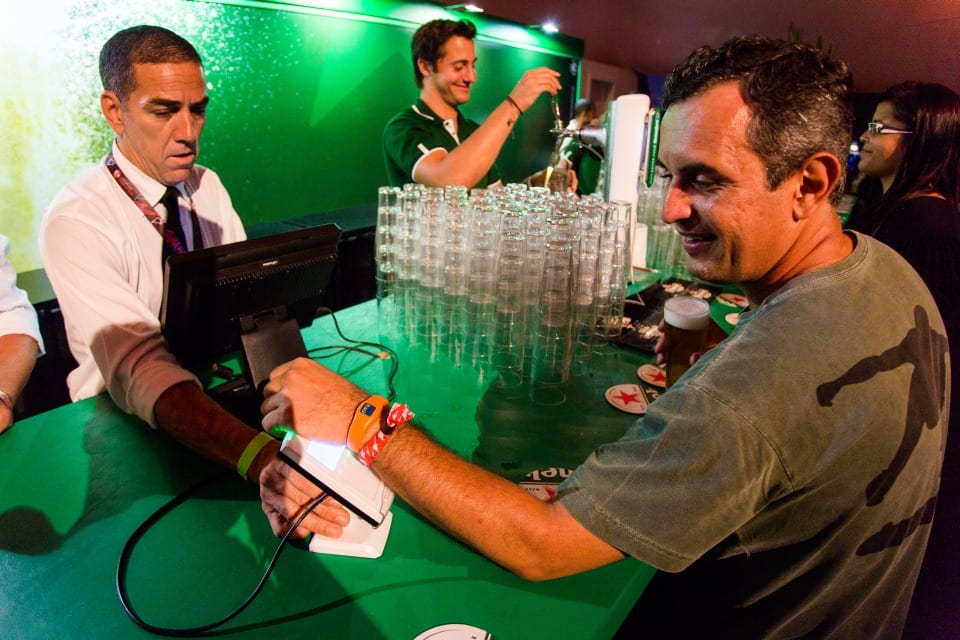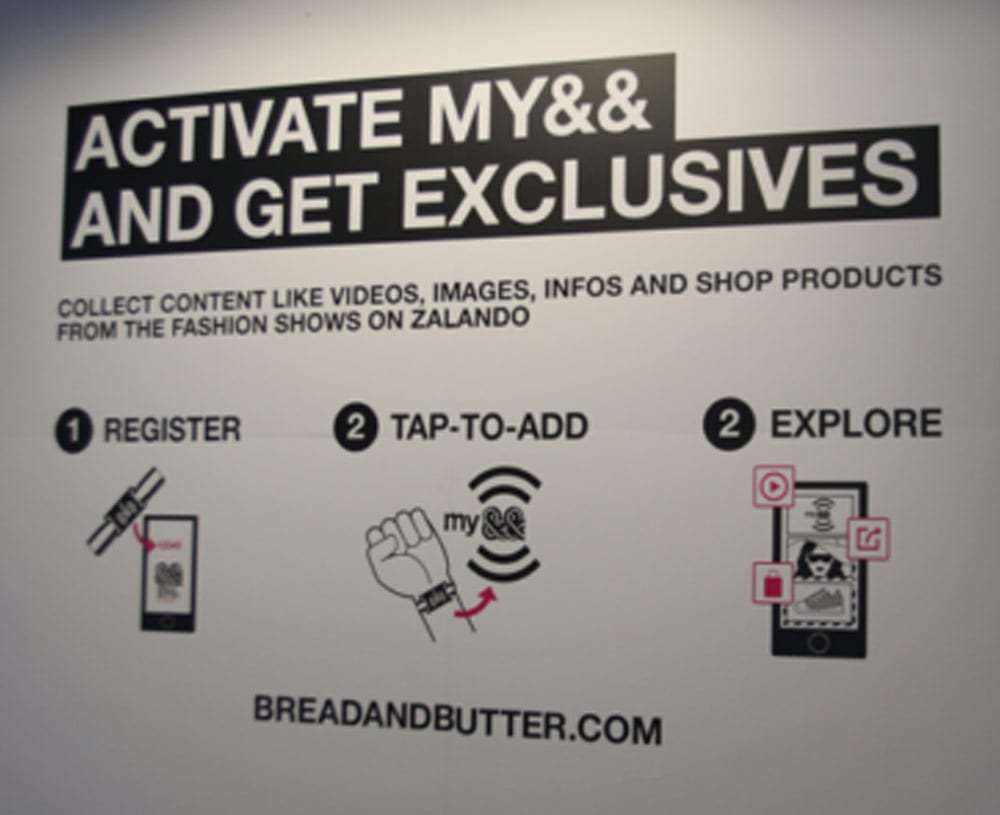1. Understand the Applications of RFID
RFID has three main areas of application: Access Control, Cashless Payments, and Brand Activation. It’s been used for Access Control for years, helping festivals eradicate ticket fraud and manage entry for multiple layers of credential rights. These clever chips also mean huge opportunities for sponsored brand activations: from photomechanics that allow instant uploads to social media sites like Facebook and Twitter, to bespoke, custom Spotify playlists and competitive games with live leader boards.

‘Fully cashless’ events benefit the most from RFID technology through a sophisticated closed-loop Cashless Payment system, whereby the only method of payment accepted across an entire event site is through a simple double-tap of a guest’s RFID wristband. The result? Faster transaction times leading to significantly reduced queues at bars, concessions, and merchandise booths, making for a better guest event experience. Vendors and event organizers see a lift of on-site event revenue by an increase of 15-30% compared to cash and credit card payment methods. Eliminating the need to carry cash also improves security for customers and organizers.
The largest benefit of integrating RFID into your event is the wealth of customer data captured digitally in real-time by the technology platform. With RFID technology, you’ll know exactly who is coming to your event, what they like to purchase and how frequently, who they are listening to on stage, what brands they interact with, and much more. This Big Data capture leads to actionable insight to making improvements for your future events, curating event content, optimizing operational processes and elevating your guest event experience.
2. Define what you need

Think carefully about why you want to introduce RFID technology in the first place and carefully define your objectives. Do you have issues with fraudulent tickets? Perhaps you’re looking to improve your access and egress times? Do you have a brand sponsor that wants to make a bigger digital impact? Do you want to increase on-site sales? Do you want more customer data to better understand your audience and measure the pulse of your event? Think about the applications of the technology and what areas of your event it can help you improve.
3. Experience RFID technology for yourself
Do you want to hear what ice cream tastes like? Of course not. You want to taste it! Think of RFID technology in the same way. Attend an event that’s using RFID technology already. Not only will you have a better understanding of how it works and its capabilities, but it will also highlight any questions or queries you might have when it comes to your event. It’s always good to see it in the view of a festival-goer and experience the technology from beginning to end. If you’ve already chosen a technology provider, they should be more than happy to host you at one of their upcoming events. Speak to the organizers, vendors, sponsors, and attendees to hear their feedback on the RFID tech.
4. Understand how the supplier’s event technology works
RFID event solutions are not built or delivered in the same manner across suppliers. For instance with Cashless Payment technology, do they use an open-loop or closed-loop system? We use a closed-loop, server-connected system, which means patrons and vendors can continue to transact without any payment interruptions with maximum up-time across your event. In contrast, an open-loop system requires connection to the outside world to process credit card transactions, which may not always be reliable in an open-air festival environment or high traffic event areas.
Ask how the technology platform works, available features, and how this compares to other suppliers. Download our latest eBook: a starter’s guide to Cashless Payment technology. Does the technology provider also offer other elements of the event experience such as wristband fulfillment (i.e. sending ticket buyers their wristbands in the mail prior to the event)? Do they take care of merchant services and customer support? Do they help manage guest refunds for leftover credit? What type of customer data is captured? Is the event provider able to share best practices and communication tools? The list goes on, but it’s important to ask these questions to help narrow down your top choice.
5. Choose your technology provider
Ensure you are partnering with a solutions provider who is specialized in RFID technology with a solid track record and long-term customers, including events similar in caliber and size to your own. A good event supplier can help you answer all of the above questions and more, and the relationship that you have with them is key to success. You need to make sure that they’re trustworthy, transparent and upfront about their capabilities.
The more deployment experience they have in the live event space is paramount, as their technical and operations team will be better equipped to resolve any challenges that may arise at your unique event. If you haven’t done step 3, ask your chosen technology provider to invite you to an upcoming event, so you can experience the technology first hand.
6. Before the Event: RFID Technology Education
Once you’ve chosen your supplier and event solution(s), you will need to educate your vendors and consumers on what RFID technology is, how it works, what are the benefits, and any other event policies. Communicate with all parties in advance, consistently, and frequently. Use all your available communication channels such as your website, social media pages, email newsletter, local media and bloggers, information brochures to accompany wristband fulfillment and more. For vendors and staff, pre-event training should also be mandatory.
To embrace the technology and ensure seamless adoption when event doors open, guests and vendors need to understand how to use the technology and how it benefits them. Your RFID partner should be by your side during this entire process to help craft the messaging for accuracy and best practices.
7. During the Event: On-site Signage and Instructions

Wristbands have been received, the equipment is in place and the event doors are about to open. No matter what you’ve communicated pre-event, your guests may still have questions. Strategically place on-site signage throughout your site map (e.g. directions to top-up stations; refund policy; how to make a cashless payment at vendor counters, and more). Also position customer service kiosks next to box office and cashless top-up stations with fully trained front line staff. Also, make sure your social media team is ready to respond to any online queries.
8. After the Event: Post-Event Communications
RFID technology unlocks huge potential to reach out to your customers far beyond the event itself. Through real-time customer data capture, engage with target audiences through post-event communications to drive further in-store sales and customer loyalty for your event, vendors, and sponsors. Some examples include sending promotional offers, pre-sale access for future events, exclusive downloadable content, an event recap of the amazing time they had, e-commerce opportunities, and more. Stay in touch with your customers and provide them with relevant content to build your fan base. For more information on how to take your event to the next level with RFID technology, download a free copy of our RFID integration guide here.
If you would like to learn more about how RFID technology can benefit your event, don’t hesitate to contact Intellitix as we are always happy to answer any questions and help with your event.
Learn more about RFID integration at events: NFC vs RFID: The Biggest Differences


